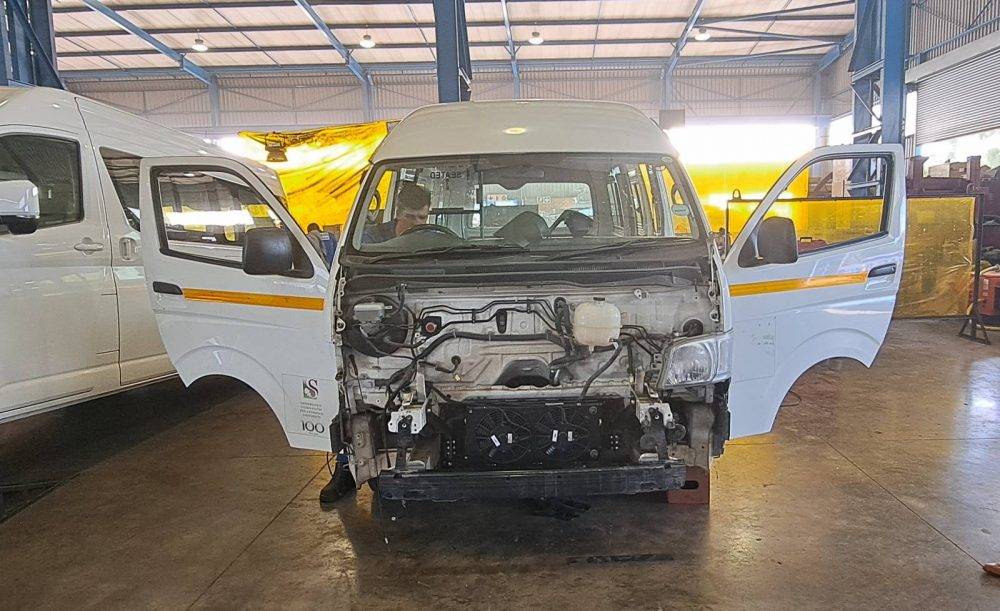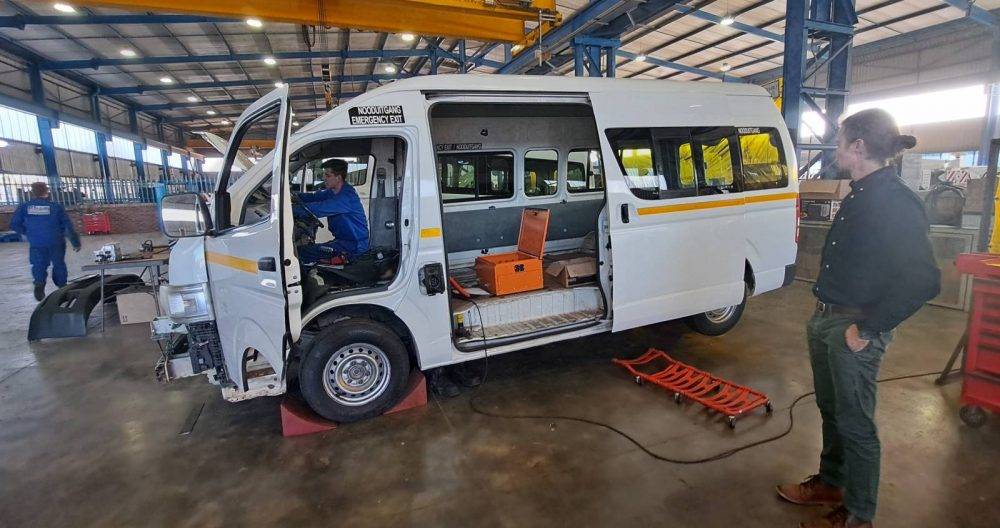Thinus Booysen calls it a “reborn taxi”. That’s how he describes the minibus taxi that he and his team have given a second life by retrofitting the fuel-driven vehicle with electric propulsion.
This first electric taxi of its kind in South Africa is the result of a collaboration between researchers at Stellenbosch University and Rham Equipment, and was funded by the South African National Energy Development Institute.
The prototype, which will be used to prove the concept and for testing, was recently completed and is now operational. It is being checked for road safety, after which performance testing will start. Its development signals the beginning of the project, says Booysen, who holds the research chair in the Internet of Things in the university’s department of electrical and electronic engineering.
“More than 70% of the trips in South Africa are by minibus in the informal sector, which is why we are hoping to encourage the retrofitting of some of the 250 000 minibuses in the country with electric propulsion,” he said.
These retrofitted vehicles would be cheaper and much more environmentally friendly than new electric vehicles (EVs).
“With this venture, we want to help build the skills that will be needed to manufacture electric vehicles locally and also create awareness about how much we could save with electric taxis.”
South Africa’s electric vehicle manufacturers have a window of opportunity to open plants in Africa to produce these cars locally, he said. Most locally manufactured petrol cars are being exported but this boon to the economy will end with developed countries transitioning to electric vehicles in the run-up to — or even before — 2035.
Remaining in the slow lane of the electric vehicle transition could put thousands of jobs at risk and the “automotive industry and our government cannot afford to be asleep at the wheel”, Booysen said.
In the long-term, local production of new electric vehicles is key.
“We just wanted one vehicle to test with so we can validate our simulation models, so we built it. But we’re also trying to build the skill set in South Africa to prepare for eventual local production because we fundamentally believe that we have to produce them locally,” Booysen added.

South Africans pay 25% import taxes on electric vehicles, compared to 18% import taxes on their internal combustion-engine counterparts. But scrapping import duties on electric vehicles is not the answer “because it’s protecting the local production of vehicles and 500 000 jobs”, he maintained.
Stephan Lacock, one of Booysen’s team members, who is doing his master’s degree in electronic engineering at Stellenbosch University, helped design the retrofitted minibus with partners at Rham Equipment.
Lacock explained that Rham Equipment had been building battery mining equipment vehicles for several years.
“If you go and look at the engineering principles, it’s actually very similar in what you will use in an electric taxi or an electric car,” he said. “I spoke to the chief executive of Rham, who estimates that he will create at least two to three jobs per vehicle that he retrofits.”
The retrofit needed to comply with national road safety regulations, particularly the strict requirement not to make any permanent changes to the minibus chassis. For the retrofit, they removed the minibus’ internal combustion engine and the petrol tank, manual transmission, gas pipe and radiator.
The team successfully created a reproducible “kit” that includes the main components of the electric powertrain — the system that propels the vehicle forward. These include an electric motor, inverter, charger, electronic control unit and a single-speed reduction gearbox.
Lacock said the powertrain is “skilfully connected” to a custom-designed battery pack that meets the specific operational needs of a minibus. Its advanced regeneration system, which harnesses energy generated during deceleration and downhill driving, enhances the vehicle’s energy efficiency and range.
The minibus is equipped to travel an estimated range of about 120km, with a maximum speed of 120km an hour. It has an electric motor power of 90kW and a battery capacity of 53.76kWh.
Lacock said this ensures it meets all load and driving requirements comparable to those of traditional internal combustion engine minibuses. The inclusion of a 20kW charger means the minibus can be efficiently charged in just over two hours.
On the potential appetite for electric minibus taxis, Booysen said that he and his team surveyed just more than 5 000 people in the taxi industry, including drivers, owners and owner/drivers. The positive response was “overwhelming”.
“They were asked about 40 or 50 questions and what became clear very quickly is they don’t have a clue what an electric vehicle is and what it means but they were happy to entertain the idea of using one as long as it’s going to save them money.”
It will.
“The retrofit we’ve done costs about R700 000. But that’s just because it’s the first one. We believe that at scale, we should be able to do them for approximately R450 000.”
To put that into context, importing an electric taxi costs R1.2 million.

A retrofitted minibus costs a lot less than importing a new vehicle and has a substantially lower environmental impact.
“But, most importantly, if you convert [a minibus taxi] to electric, it takes a year to pay off in terms of savings in diesel and petrol versus electricity,” said Booysen.
While optimistic about retrofitting taxis, Booysen said there are difficulties in charging the vehicles in a country where the national electricity grid already operates at half its capacity. “The big question is, what about the grid?
“I can tell you now, when taxis start charging from the grid, it won’t work. All our simulations show that we will kill the grid. It’s going to require 5% to 10% of the grid just to charge the taxis.”
Booysen said it is imperative that whoever instals charging stations makes use of as much renewable energy as possible. They also need to install large battery banks to act as a buffer between the electricity grid and the vehicle chargers.
Johan Giliomee, a PhD student and a team member, said most taxis are stationary between the early morning and afternoon peaks, making it an ideal opportunity for charging from solar panels.
“This also means a single charge would only need to supply sufficient energy for half the day, significantly reducing the required battery capacity as opposed to being scaled to support a full day’s operations,” he said. “Further ideal charging opportunities are seen overnight when the national electricity demand is at its lowest.”
The team is advocating a new paradigm of electric mobility, which includes the system of charging, rather than electric vehicles alone.
“We need to stop talking about electric vehicles and start thinking about the whole system of electric mobility,” Booysen said. “You can’t just buy a car and just assume that there will be fuel just round the corner. You need to buy a car and, at the same time, ensure that you produce electricity for it.”
He suggested that the government subsidise the installation of solar power and the battery banks for people who buy electric vehicles, as is being done in other countries.
“The one thing that we have in this country is incredibly stupid and ridiculous inequality, which means that those people who can afford to buy EVs right now, they’re probably in the position where they can produce their own electricity and probably already do, because of load-shedding.”
For Booysen, the big question centres on taxi drivers and owners. “At that point it’s where the Development Bank of Southern Africa, the World Bank, et cetera, need to come to the party and say, ‘Let’s finance this because there’s a good business opportunity here and the money will be paid back in a year, which means on top of paying off the vehicle, which will be cheaper now, let’s let them pay back the investment in solar as well.’”
Booysen’s team will now collaborate with Rham Equipment and Golden Arrow Bus Service to retrofit one of the company’s diesel buses.